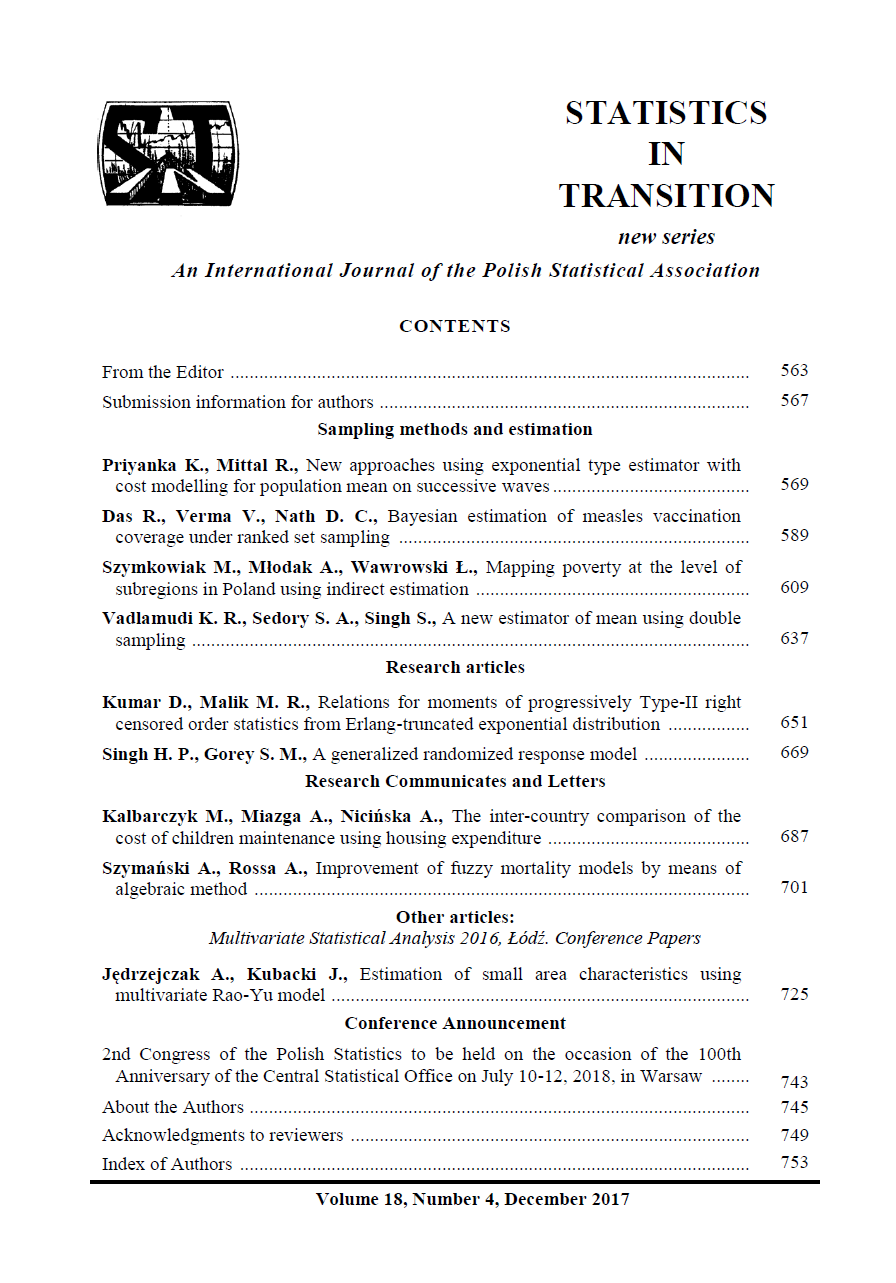ARTICLE
ABSTRACT
In this paper we have suggested a generalized version of the Gjestvang and Singh (2006) model and have studied its properties. We have shown that the randomized response models due to Warner (1965), Mangat and Singh (1990), Mangat (1994) and Gjestvang and Singh (2006) are members of the proposed RR model. The conditions are obtained in which the suggested RR model is more efficient than the Warner (1965) model, Mangat and Singh (1990) model and Mangat (1994) model and Gjestvang and Singh (2006) model. A numerical illustration is given in support of the present study.
KEYWORDS
sensitive variable, population proportion, Gjestvang and Singh’s model, variance, efficiency.
REFERENCES
ANTONAK, R. F., LIVNEH, H., (1995). Randomized response technique: A review and proposed extension to disability attitude research. Genetic, Social, and general Psychology Monographs, 121, pp. 97–145.
BOUZA, C. N., HERRERA, C., MITRA, P. G., (2010). A Review of Randomized Responses Procedures: The Qualitative Variable Case. Revista Investigación Operacional, 31 ( 3), 240–247.
CHAUDHURI, A., MUKERJEE, R., (1987). Randomized Response Technique: A Review. Statistica Neerlandica, 41, pp. 27–44.
CHAUDHURI, A., MUKERJEE, R., (1988). Randomized Response. Statistics: Textbooks and Monographs, Vol. 85, Marcel Dekker, Inc., New York, NY.
CHAUDHURI, A., CHRISTOFIDES, T. C., RAO, C. R., (2016). Data Gathering, Analysis and Protection of Privacy Through Randomized Response Techniques: Qualitative and Quantitative Human Traits. Handbook of Statistics 34.
FISHER, M., KUPFERMAN, L. B., LESSER, M., (1992). Substance use in a school-based clinic population: Use of the randomized response technique to estimate prevalence. Journal of Adolescent Health, 13, pp. 281–285.
GJESTVANG, C. R., SINGH, S., (2006). A New Randomized Response Model.Journal of the Royal Statistical Society, B. 68, pp. 523–530.
JARMAN, B. J., (1997). The Prevalence and Precedence of Socially Condoned Sexual Aggression Within a Dating Context as Measured by Direct Questioning and the Randomized Response Technique
MANGAT, N. S., SINGH, R., (1990). An Alternative Randomized Procedure. Biometrika, 77, pp. 439–442.
MANGAT, N. S., (1994). An Improved Randomized Response Strategy. Journal of the Royal Statistical Society., B, 56 (1), pp. 93–95.
ODUMADE, O., SINGH, S., (2008). Generalized Force Quantitative Randomized Response Model: A Unified Approch. Journal of the Indian Society and Agricultural Statistics, 62 (3), pp. 244–252.
ODUMADE, O., SINGH, S., (2009). Improved Bar-Lev. Bobovitch, Boukai Randomized Response Model. Communications in Statistics – Simulation and Computation, 38, pp. 473–502.
ODUMADE, O., SINGH, S., (2009). Efficient Use of Two Decks of Cards in Randomized Response Sampling. Communications in Statistics – Theory and Methods 38, pp. 439–446.
ODUMADE, O., SINGH, S., (2010). An Alternative to The Bar-Lev, Bobovitch and Boukai Randomized Response Model. Sociological Methods And Research. Doi10.1177/0049124110378094.
SINGH, S., (2003). Advanced Sampling Theory With Applications. Kluwer Academic Publishers, Dordrecht.
WARNER, S. L., (1965). Randomized Response: A Survey Technique For Eliminating Evasive Answer Bias. Journal of the American Statistical Association, 60, pp. 63–69.
WEISSMAN, A. N., STEER, R. A., LIPTON, D. S., (1986). Estimating illict drug use through telephone interviews and the randomized response technique. Drug and Alcohol Dependence, 18, 225–233.
WILLIAMS, B. L., SUEN, H., (1994). A Methodological Comparison of Survey Techniques in Obtaining Self-Reports of Condom-Related Behaviors. Psychological Reports, 7, pp. 1531–1537
